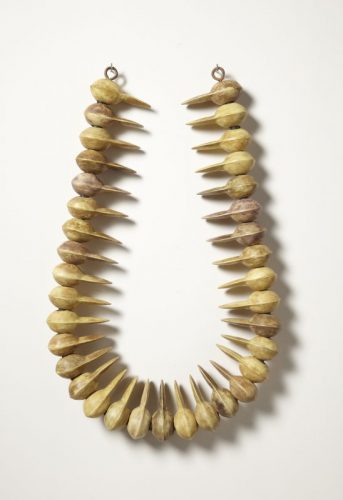When ceramicist Sharif Bey was teaching full time and completing his doctorate at Pennsylvania State University, he didn’t have time to disappear into the studio for hours on end. So he started making pinch pots, shaping the clay into bowls in the palm of his hand. He could make them at home while watching his children and finish them in his fireplace. Eventually, musing on themes of ornamentation and status, some of the pots became beads, which he strung together into massive necklaces.
A decade later, the necklaces have been exhibited in galleries around the world and are prized by art collectors. It’s a fitting irony that Bey’s creations from the humblest of materials and simplest of processes are now lauded in the rarified art world. The subjectivity of value, and challenges to conventional definitions, are central to his work as an artist and educator.
Now a professor in both the College of Visual and Performing Arts (VPA) and the School of Education at Syracuse University, Bey discovered pottery through community programming in his hometown of Pittsburgh. He was a dedicated ceramicist by age 15. He earned bachelor’s and master’s degrees in fine art, then returned to Pittsburgh to teach at the same place his passion for ceramics was ignited.
Bey saw that the corrosive effects of poverty and prejudice had changed his community. His immersion in art had provided an escape, but now Bey questioned the assumed goals of his trajectory: entrance into the insular world of academics and the esteem of an elite art market. “I started to ask myself, ‘What does what I’m doing have to do with what’s happening to my neighborhood, my family?’” he says.
This formative period of questioning led to one of Bey’s personal philosophies about the meaning and value of art: Context determines the value of objects, but the inherent value of art is in the act of making it. Making art—whether that be feeling out chords on an instrument, sanding wood smooth, composing ingredients into a dish or any other physical process of a creative endeavor—provides conditions for building confidence, overcoming inhibitions and stirring resolve. These benefits manifest in all other aspects of a person’s life. “Making art makes for a more fierce, more engaged citizen,” Bey says.

Any little bit [of art creation] is better than nothing, and if you let it, art will change you.
This perspective underpins Bey’s passionate advocacy for the accessibility of art education and incorporation of artistic creation into everyday life. He challenges the view that art education is valuable only for those who hope to pursue it professionally. Bey draws a parallel between making art and physical exercise. Just as we recognize that regular exercise benefits anyone, so too does artistic creation. “Any little bit is better than nothing,” he says. “And if you let it, art will change you.”
Bey balances his time as a professor and scholar with a prolific studio practice and frequent exhibitions. Although this makes for a busy schedule, Bey believes that to truly advocate for the value of something, one has to model it. He sees his roles as interdependent. His research informs his art, his art influences his teaching, and teaching, he says, inspires him to keep learning.
In May, Bey received the Judith Greenberg Seinfeld Scholar award in recognition of outstanding work as an artist, scholar and teacher. Bey says Syracuse University is extraordinary in their support for faculty who are also active professional artists, which allows him to be innovative and responsive as an educator.
